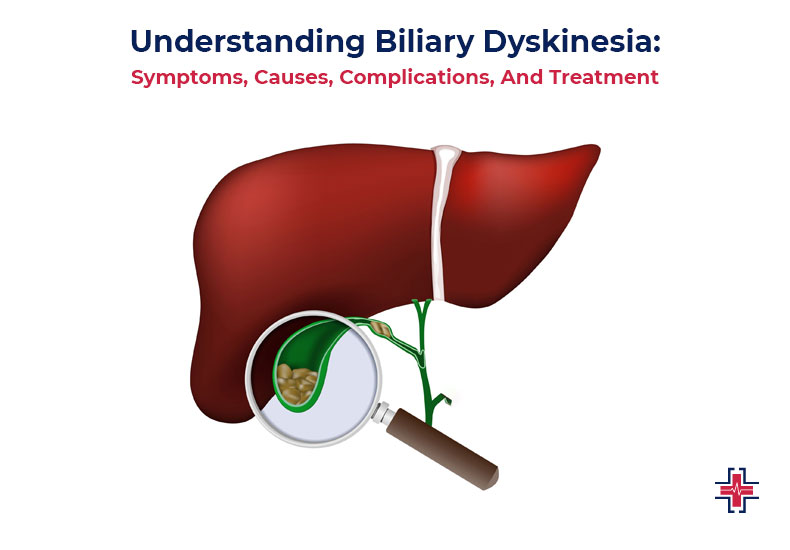A disorder known as biliary dyskinesia impairs the gallbladder’s ability to operate normally, resulting in some symptoms and discomforts. For those who are having similar symptoms, understanding this illness is essential to obtaining the right treatment. This post will go into great length on biliary dyskinesia, including its causes, available treatments, physical effects, potential for improvement, and the ideal diet to follow while managing the illness.
Having a thorough grasp of biliary dyskinesia enables people to seek medical attention and make decisions regarding their health. By answering the queries and worries related to this illness, we hope to offer insightful information that will guide readers on their path to improved health and well-being. If you are experiencing symptoms of gallbladder disease, don’t wait to get treatment in Mesquite.
What Is Biliary Dyskinesia?
A functional disorder that mostly affects the gallbladder is called biliary dyskinesia. It can occasionally damage the sphincter, a tiny muscle that sits where your gallbladder empties into your small intestine. An issue with an organ or muscle’s ability to function is known as a functional dysfunction. (This is not the same as a gallstone or other mechanical obstruction.)
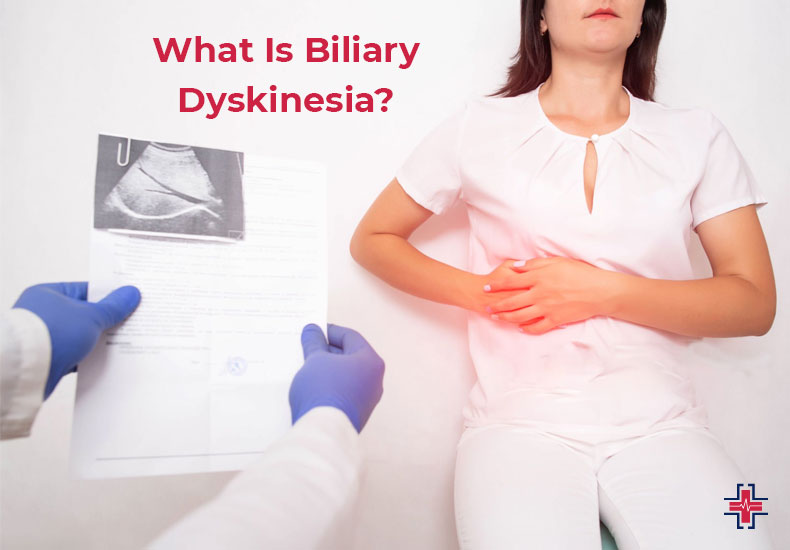
The primary job of the gallbladder is to hold the bile produced by the liver and transfer it to the small intestine for aiding in digestion. Your small intestine uses hormones to alert your gallbladder when it’s time to start the digestion process. To force bile into the bile ducts, which will carry it to your small intestine, your gallbladder contracts.
A disruption in these processes is known as biliary dyskinesia. Something isn’t functioning properly somewhere along the line. The hormonal signaling, the nerves that are meant to receive the signal, or the muscles that are meant to respond could all be involved in the issue. Medical professionals can detect that your gallbladder isn’t expelling enough bile, even though they may first have trouble identifying which condition it is.
Who Gets Biliary Dyskinesia?
It is only recently that functional gallbladder problems have received increased attention and reporting, especially in the United States. We don’t yet know if biliary dyskinesia is genuinely growing more widespread or is merely getting more attention, or if this trend is specific to the United States. It’s unclear if some individuals will be impacted more than others. However, diabetes and obesity may be risk factors.
Numerous effects of obesity on metabolism have been documented. It can promote chronic inflammation and cause fat to accumulate in your organs. Gallbladder motility—the movement of your gallbladder—is impacted by both of these variables. Gallstones can result from condensed, sludgy static bile.
How Does Biliary Dyskinesia Affect My Body?
The backlog of bile that results from your gallbladder’s inability to effectively empty into your bile ducts makes your gallbladder larger and fuller (distended). This is comparable to having a gallstone obstruct your gallbladder. Your gallbladder may expand and retain bile, which can lead to pain, inflammation, and infections (cholecystitis).
You might experience nausea and sporadic upper abdomen pain, particularly after eating as your gallbladder tries to contract. Biliary colic is the term for this. Furthermore, especially after consuming fatty meals, inadequate bile in the stomach can result in nausea, vomiting, and bloating in the abdomen as well as poor digestion.
The consensus has been that gallstones (cholelithiasis) are nearly usually the cause of biliary discomfort. However, medical professionals are starting to recognize that might not be the case. There is growing recognition that gallbladder illness is frequently caused by biliary dyskinesia. Both adults and older children are frequently impacted by it.
Biliary Dyskinesia Symptoms
Typical symptoms of biliary dyskinesia include:
- Pain in the upper right quadrant of the abdomen.
- The build-up of pain over some time.
- Stomach bloating.
- Symptoms include nausea and vomiting.
- The loss of weight was unintended.
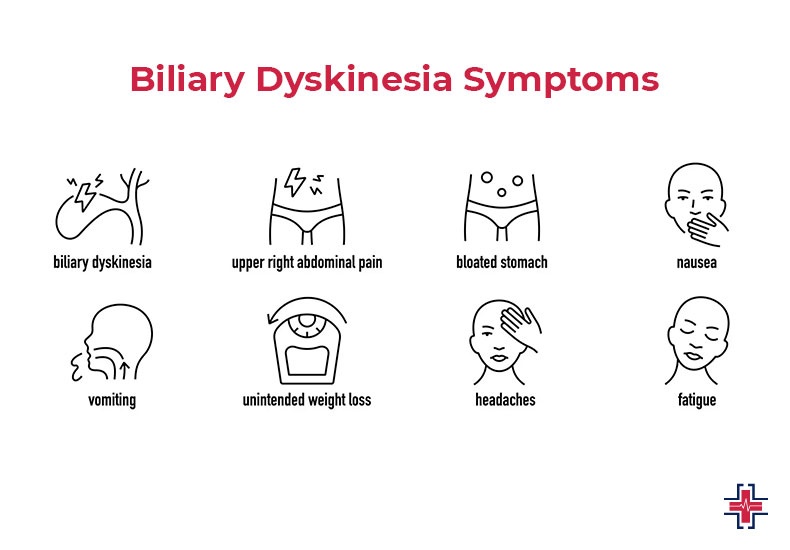
Some people also report:
- Having headaches.
- Tiredness.
- Acid reflux is a chronic condition.
- IBS and/or functional indigestion.
- A feeling of anxiety or depression.
These symptoms could appear and disappear, stay consistent, or even sometimes get worse. Under specific conditions, the pain could get really bad and come with a fever and shivering.
Additionally, patients may experience jaundice, which is defined as a yellowing of the skin and eyes and is caused by an increase in the blood level of bilirubin.
People with biliary dyskinesia may also have excessive weariness and exhaustion in addition to their physical symptoms, which can make it difficult for them to meet the demands of their daily routine.
In addition to the physical discomfort associated with biliary dyskinesia, individuals may have psychological symptoms like anxiety and sadness.
Although biliary dyskinesia has no known cure, its symptoms can be managed with medication, dietary modifications, lifestyle adjustments, and, in certain cases, surgery. If the right treatment is given, patients have a fair chance of having normal, comfortable lives.
Biliary Dyskinesia: How Does It Feel?
The upper right region of the abdomen, just under the right rib cage, is where most people have gallbladder pain. However, some report feeling it in the middle of their belly, while others report feeling it in their back or right shoulder. It happens in spurts, sometimes lasting up to several hours. For the first twenty minutes, the discomfort increases gently before progressively decreasing.
Episodes don’t happen daily, but they do happen occasionally. They most frequently occur after meals, particularly rich or fatty ones. The gallbladder is meant to contract at this point to discharge the bile into your intestine. Usually, the pain is bad enough to keep you from doing your normal tasks. It can take you to the emergency department or wake you up in the middle of the night. Vomiting and nausea are also frequent.
Biliary Dyskinesia Causes
Most medical professionals are unaware of the underlying reasons for motility issues. Certain nerves, such as the vagus nerve, can malfunction occasionally. However, it’s typically tough to pinpoint the precise location of the issue. The particular motility of your gallbladder or biliary sphincter may occasionally be impacted by a more widespread metabolic problem or an intestinal motility issue.
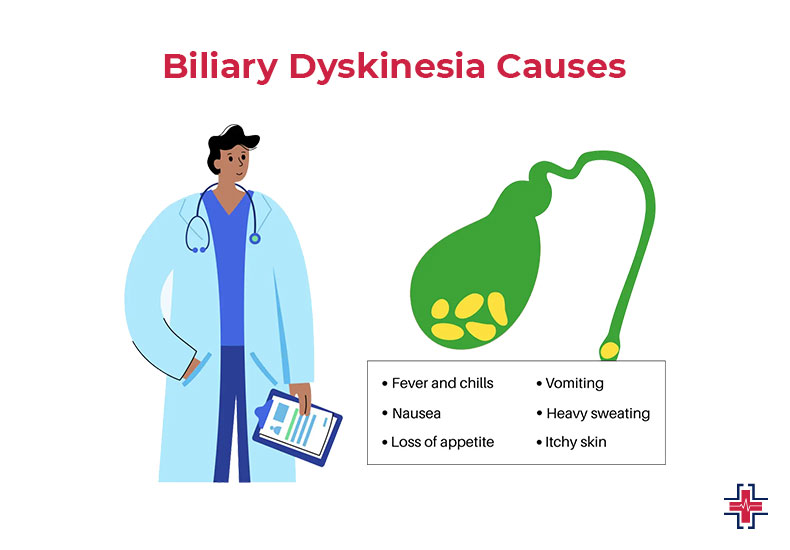
It is uncertain what specifically causes biliary dyskinesia. An underlying metabolic condition that interferes with food passage via the gastrointestinal (GI) tract is one potential explanation. Another possible cause is an issue with the gallbladder itself.
The majority of people with biliary dyskinesia are older adults and children. It is a typical pediatric diagnosis. Biliary dyskinesia has emerged as the most frequent cause of gallbladder removal in certain pediatric hospitals.
Biliary Dyskinesia Treatment
Evidence does not support the idea that biliary dyskinesia will resolve on its own. It usually takes at least three months for biliary dyskinesia symptoms to be identified. By now, most people don’t want to keep waiting for it to go away on its own. If so, it was probably a different kind of motility impairment brought on by transient circumstances rather than a true functioning disorder.
Gallbladder excision (cholecystectomy) is the only known successful treatment for gallbladder biliary dyskinesia. You can typically return home the same day after this laparoscopic procedure, which is less invasive. Small, keyhole incisions are used during laparoscopic surgery, which heals more quickly and causes less discomfort and scarring. You don’t need your gallbladder to survive. Bile will now travel straight to your small intestine from your liver.

Should your medical professional conclude that the sphincter muscle is the source of the motility impairment, an endoscopic treatment can be used to broaden or open this muscle. Usually, this treatment is carried out if your symptoms still exist after having your gallbladder removed. Not only is it challenging to diagnose sphincter dysfunction, but it is also uncommon for the motility issue to be limited to the sphincter. Frequently, your gallbladder is also impacted. Biliary dyskinesia treatment without surgery is not possible in any case. A sphincterotomy can help prevent spasms by cutting the sphincter of the Oddi muscle if symptoms don’t fully resolve.
How Is Biliary Dyskinesia Diagnosed?
Diagnosing functional diseases such as biliary dyskinesia involves multiple processes. Healthcare professionals need to:
- Verify that the pain you’re experiencing is indeed biliary and not just any other kind of stomach ache.
- Verify that you don’t have gallstones or any other more specialized form of biliary disease.
- Verify that not enough bile is being expelled by your gallbladder.
- Verify that the contraction of your gallbladder causes your symptoms.
- Verify that nothing other than drugs or other factors is influencing the motility of your gallbladder.
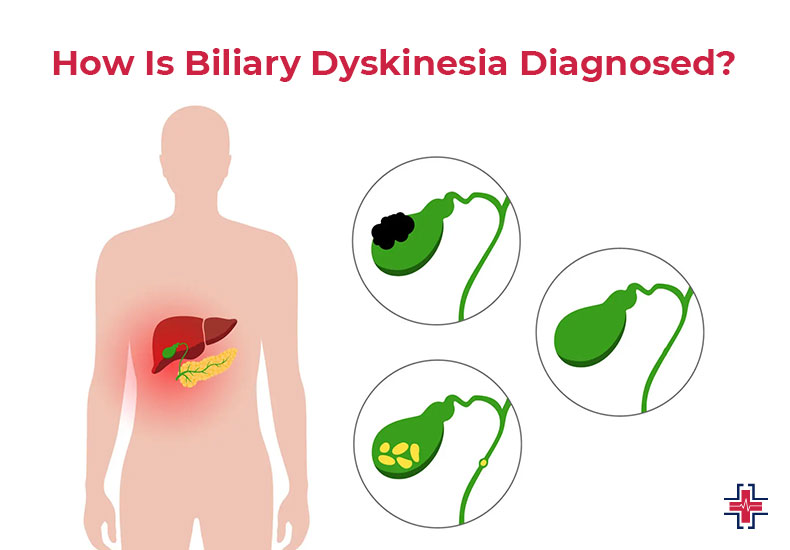
Symptom Check
They will start by inquiring about your symptoms and observing the telltale signs of biliary colic. Among these requirements are:
- Upper abdominal pain that typically affects the right side.
- Pain that lasts for at least thirty minutes and flares up periodically.
- Pain steadily increases to a moderate to severe degree.
- Posture adjustments, antacids, vomiting, or bowel motions do not relieve pain.
- There have been consistent episodes for a minimum of three months.
Disease Check
Your healthcare professional will check to rule out other prevalent causes of biliary pain once they have determined that your symptoms satisfy these requirements. They’ll accept:
- Tests on blood to measure liver and pancreatic enzyme levels. Elevated levels of enzymes may suggest an issue with any of these organs or a bile backup (particularly elevated bilirubin).
- An ultrasound of the abdomen to examine the bile ducts and gallbladder. They will search for structural issues such as gallstones, thickness of the gallbladder wall, or dilated bile ducts as reasons of biliary pain.
Gallbladder Function Check
The gallbladder function test will be the next step if your results from the ultrasound and blood tests are normal. A HIDA scan, a kind of nuclear medicine imaging test, is used by medical professionals to do this. A radioactive isotope, or tracer, is injected into your vein by the technician during the test. After passing through your biliary system, the tracer is read by a computer scanner, which displays images on a screen.
Healthcare professionals add a cholecystokinin check, an additional step to the test, to assess your gallbladder function. The hormone that instructs your gallbladder to contract and release bile into your bile ducts is called cholecystokinin. When your gallbladder contracts, your technician will inject cholecystokinin into your vein and take further pictures. They’ll watch and record their measurements.
Frequently, doctors at the ER of Mesquite are only able to identify sphincter of Oddi dysfunction after ruling out all other potential reasons of biliary tree motility problems. In certain cases, they even diagnose patients after the gallbladder has been removed but before their symptoms have improved.
Is Biliary Dyskinesia Dangerous?
The gallbladder is meant to contract at this point in order to discharge the bile into your intestine. Usually, the pain is bad enough to keep you from doing your normal tasks. It can take you to the emergency department or wake you up in the middle of the night. Vomiting and nausea are also frequent.
Diet that Helps You Treat Biliary Dyskinesia
Fruits, vegetables, seafood, lean meats, low-fat dairy products, and cooked beans are examples of healthy eating. Find out if you require a specific diet. Your doctor could advise you to follow a low-fat diet. Pick for healthy fats like those found in almonds, avocados, canola oil, and olive oil.
Final Thoughts
Pain in the gallbladder has unique characteristics. Both you and your doctor at the ER of Mesquite will probably initially assume gallstones when you diagnose biliary colic. That is accurate. What occurs, though, if they are unable to diagnose you with gallstones despite your symptoms? It’s possible that you have a functional gallbladder issue. Biliary dyskinesia diagnosis is a procedure. However, the treatment is likely to be successful if the diagnosis matches.
Make an appointment at the ER of Mesquite to receive professional care. Become in charge of your health and alleviate biliary dyskinesia. Get in touch with us right now!
